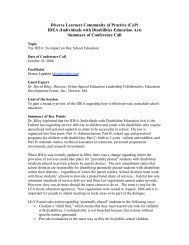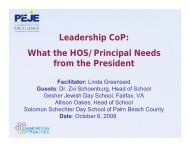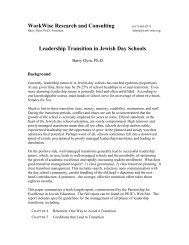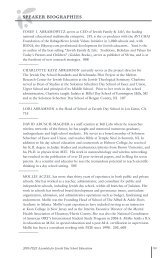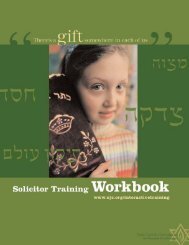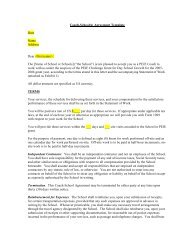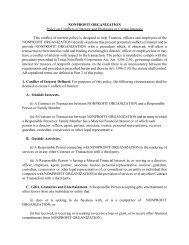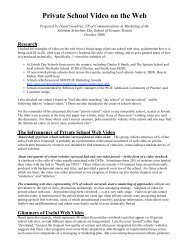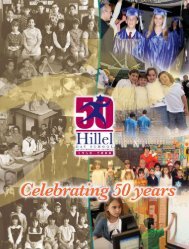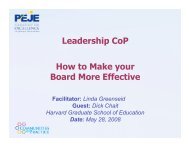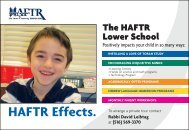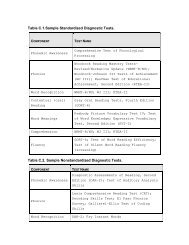âA Lifetim e of Learningâ - Partnership for Excellence in Jewish ...
âA Lifetim e of Learningâ - Partnership for Excellence in Jewish ...
âA Lifetim e of Learningâ - Partnership for Excellence in Jewish ...
You also want an ePaper? Increase the reach of your titles
YUMPU automatically turns print PDFs into web optimized ePapers that Google loves.
Rabbi Elyse Goldste<strong>in</strong> is the Directorand Rosh Yeshiva <strong>of</strong> Kolel: A Centre <strong>for</strong>Liberal <strong>Jewish</strong> Learn<strong>in</strong>g <strong>in</strong> Toronto.EXTRACT FROM:The Study <strong>of</strong> Text as a Religious ExerciseRabbi Elyse Goldste<strong>in</strong> • This article orig<strong>in</strong>ally appeared <strong>in</strong> the CCAR Journal, Spr<strong>in</strong>g 1999, and is repr<strong>in</strong>ted with permission; ed.The Need <strong>for</strong> Mean<strong>in</strong>gIt is usually a “trigger event” which causes adults to first enter <strong>in</strong>toadult education. A death, an <strong>in</strong>termarriage, or an upcom<strong>in</strong>g Bar or BatMitzvah catapult a need <strong>for</strong> immediate <strong>in</strong><strong>for</strong>mation and move a personto dabble at first <strong>in</strong> a class. For those who stay, once their immediatequestions are answered, the <strong>in</strong><strong>for</strong>mational model is <strong>in</strong>sufficient. Althoughdetails, facts, and data seem to be the goal <strong>of</strong> the learner, itsoon becomes obvious that adult learners are seek<strong>in</strong>g much more than<strong>in</strong><strong>for</strong>mation. Anne Sokol and Patricia Cranston have noted that “Adulteducation has moved beyond… the ‘bank<strong>in</strong>g model’ <strong>of</strong> teach<strong>in</strong>g <strong>in</strong>which educators make deposits <strong>of</strong> <strong>in</strong><strong>for</strong>mation <strong>in</strong>to the empty vaults <strong>of</strong>students’ m<strong>in</strong>ds.” 1 They suggest that adult education is about trans<strong>for</strong>mation,not tra<strong>in</strong><strong>in</strong>g. Adult learners who stay are hungry <strong>for</strong> trans<strong>for</strong>mation,and they sense that traditional texts and traditional text studymay lead to it. They sense that a text is not merely a text, not only awritten document <strong>of</strong> historical or sociological significance, but reflect<strong>in</strong>gdeep philosophical and spiritual value as well. They stay to f<strong>in</strong>dout if their hunch is correct. And <strong>of</strong>ten it is. It is <strong>in</strong> this second model<strong>of</strong> adult education, the trans<strong>for</strong>mational model, that the study <strong>of</strong> textbecomes a religious exercise.What does the religious study <strong>of</strong> text look like? It depends much lesson frontal, lecture methodology because the role <strong>of</strong> the teacher is notto pour <strong>in</strong><strong>for</strong>mation <strong>in</strong>to wait<strong>in</strong>g students, but to help students extractultimate and existential mean<strong>in</strong>g <strong>for</strong> themselves. It uses the chevruta(partner) and small group model more, giv<strong>in</strong>g students the opportunityto <strong>in</strong>quire <strong>of</strong> each other. It is not afraid <strong>of</strong> cacophony, <strong>of</strong> small groups<strong>in</strong> a room each struggl<strong>in</strong>g with a text, just with<strong>in</strong> hear<strong>in</strong>g range <strong>of</strong>each other. It is Socratic <strong>in</strong> nature, focus<strong>in</strong>g much more on questionsthan on answers. It may concentrate on depth, rather than breadth, <strong>of</strong>a certa<strong>in</strong> subject or a particular text.The religious study <strong>of</strong> a text may manifest itself <strong>in</strong> a concern with therelationship between the teacher and the students. In many cases, theteacher is not only purveyor <strong>of</strong> knowledge, but classical spiritualguide; not only Rabbi, but Rebbe. Unafraid to use his or her own life asa model — both positive and negative — the teacher teaches personally,so that the students can move the material from the head to theheart. The teacher serves as a conduit <strong>for</strong> the life changes such studymay present, and also functions as a k<strong>in</strong>d <strong>of</strong> shadchan (matchmaker) tohelp spiritually search<strong>in</strong>g students f<strong>in</strong>d each other.Religious study <strong>of</strong> text <strong>of</strong>fers no external rewards. It is — and it feelslike —Torah lishmah, study only <strong>for</strong> the sake <strong>of</strong> study. There are no certificates,no degrees, no titles. There is no graduation. There isn’t evena true “end” <strong>of</strong> the class or semester, and some study courses may goon <strong>for</strong> years and years on the same text or same topic. There is alwaysmore to learn, and we aren’t necessarily “gett<strong>in</strong>g anywhere” <strong>in</strong> particular.In this way, the “religious” study <strong>of</strong> text differs significantly fromthe “academic” study <strong>of</strong> texts found <strong>in</strong> university <strong>Jewish</strong> Studies programs.The religious study <strong>of</strong> text beg<strong>in</strong>s with the question, “What message isthis text try<strong>in</strong>g to teach me about how to be a good Jew?”, and onlyends with the question, “How do I do such-and-such?” The religiousstudy <strong>of</strong> text asks the learner to confront received prejudices andreread the text with new eyes. It does not attempt to answer the question,“is this true?” — mean<strong>in</strong>g — “did this really happen?” but helpsthe learner reframe the question <strong>in</strong>to “is this True?”— mean<strong>in</strong>g—“what Truth will this shed <strong>in</strong> my life to guide me?”And <strong>in</strong> the end, the religious study <strong>of</strong> text will lead the learner on apersonal quest <strong>for</strong> the answer to that question <strong>of</strong> Truth. This personalquest will, the teacher hopes, lead the learner <strong>in</strong>to observance, lifechanges, <strong>in</strong>creased attachment to <strong>Jewish</strong> tradition, and <strong>in</strong>creased need<strong>for</strong> <strong>Jewish</strong> community. The religious study <strong>of</strong> text goes beyond scientific<strong>in</strong>quiry, historical analysis, or contextual exam<strong>in</strong>ation. It is study<strong>in</strong> fulfillment <strong>of</strong> <strong>Jewish</strong> commitment. Thus, the religious study <strong>of</strong> textis “missionary” <strong>in</strong> that it has a mission.P A G E 30 • C O N T I N U I T Y M A G A Z I N E



